Yamaha MT 400 User Manual
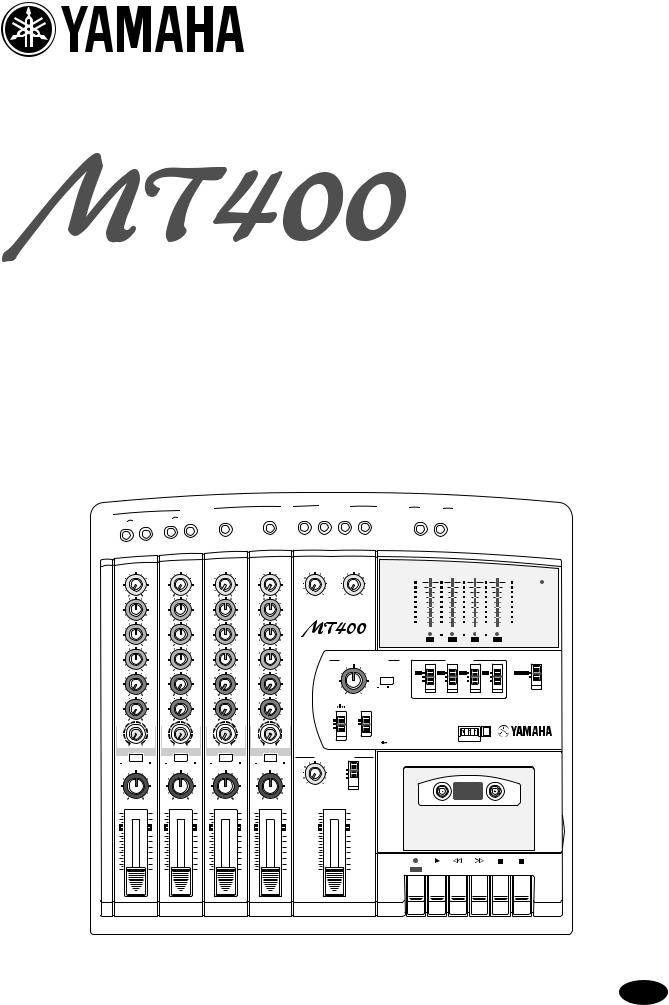
MULTITRACK CASSETTE RECORDER
Owner’s Manual
1
INSERT I/O
2
MIC/LINE INPUT INSERT I/O
|
|
|
STEREO INPUT |
|
|
3 |
4 |
5L |
6R |
7L |
8R |
AUX SEND
1 2
|
1 |
|
2 |
|
3 |
|
4 |
|
5L–6R |
7L–8R |
|
|
|
|
|
|
GAIN |
|
GAIN |
|
GAIN |
|
GAIN |
|
LEVEL |
LEVEL |
|
|
|
|
|
|
|
|
|
|
|
|
|
|
|
|
|
|
|
+6 |
|
|
|
+6 |
|
|
|
|
|
|
|
|
|
|
|
|
|
|
|
|
POWER |
LINE |
MIC |
LINE |
MIC |
LINE |
MIC |
LINE |
MIC |
0 |
10 |
0 |
10 |
+3 |
|
|
|
+3 |
|
|
|
|
|
||||||||||||
HIGH |
|
HIGH |
|
HIGH |
|
HIGH |
|
|
|
|
|
0 |
|
|
|
0 |
|
|
|
|
|
|
|
|
|
|
|
|
–5 |
|
|
|
–5 |
–12 |
+12 |
–12 |
+12 |
–12 |
+12 |
–12 |
+12 |
|
|
|
|
–10 |
|
|
|
–10 |
MID |
|
MID |
|
MID |
|
MID |
|
|
|
|
|
|
|
|
||
|
|
|
|
|
|
|
|
|
|
|
|
|
||||
|
|
|
|
|
|
|
|
|
MULTITRACK CASSETTE RECORDER |
REC |
|
|
|
|
||
|
|
|
|
|
|
|
|
|
|
|
|
1 |
2 |
3 |
|
4 |
–12 |
+12 |
–12 |
+12 |
–12 |
+12 |
–12 |
+12 |
|
|
|
|
L |
R |
|
|
|
LOW |
|
LOW |
|
LOW |
|
LOW |
|
|
|
|
|
|
|
|
|
|
|
|
|
|
|
|
|
|
|
|
TAPE SPEED CONTROL |
|
REC SELECT |
|
METER SELECT |
||
–12 |
+12 |
–12 |
+12 |
–12 |
+12 |
–12 |
+12 |
|
|
PITCH |
|
1 |
2 |
3 |
4 |
4TR |
AUX |
|
AUX |
|
AUX |
|
AUX |
|
|
|
|
|
|||||
1 |
|
1 |
|
1 |
|
1 |
|
|
|
|
|
OFF |
OFF |
OFF |
OFF |
STEREO |
|
|
|
|
|
|
|
|
|
|
|
|
L |
R |
L |
R |
|
|
|
|
|
|
|
|
|
|
|
|
4.8/ |
9.5 |
|
|
|
|
0 |
10 |
0 |
10 |
0 |
10 |
0 |
10 |
|
|
– |
+ |
|
|
|
|
|
AUX |
|
AUX |
|
AUX |
|
AUX |
|
|
|
|
|
|
|
|
|
|
2 |
|
2 |
|
2 |
|
2 |
|
|
|
|
|
|
|
|
|
|
ZERO STOP
0 |
10 |
0 |
10 |
0 |
10 |
0 |
10 |
|
ON |
ON |
MIX |
CUE |
MIX |
CUE |
MIX |
CUE |
MIX |
CUE |
|
OFF |
OFF |
|
|
|
|
|
|
|
|
|
SYNC |
|
0 |
10 |
0 |
10 |
0 |
10 |
0 |
10 |
|
|
|
MIC/LINE |
TAPE |
MIC/LINE |
TAPE |
MIC/LINE |
TAPE |
MIC/LINE |
TAPE |
|
|
|
to L |
MIC/ |
to R |
MIC/ |
to L |
MIC/ |
to R |
MIC/ |
|
MONITOR/PHONES |
|
TAPE |
TAPE |
TAPE |
TAPE |
|
||||||
LINE |
LINE |
LINE |
LINE |
LEVEL |
|
|
||||
INPUT-FLIP |
INPUT-FLIP |
INPUT-FLIP |
INPUT-FLIP |
|
|
|||||
|
|
|
||||||||
|
|
|
|
|
|
|
|
|
STEREO |
|
PAN |
|
PAN |
|
PAN |
|
PAN |
|
|
ST+CUE |
|
|
|
|
|
|
CUE |
|
||||
|
|
|
|
|
|
|
|
MIN |
MAX |
|
L |
R |
L |
R |
L |
R |
L |
R |
|
STEREO |
|
|
|
|
|
|
|
|
|
|
|
|
10 |
10 |
10 |
10 |
10 |
9 |
9 |
9 |
9 |
9 |
8 |
8 |
8 |
8 |
8 |
7 |
7 |
7 |
7 |
7 |
6 |
6 |
6 |
6 |
6 |
5 |
5 |
5 |
5 |
5 |
4 |
4 |
4 |
4 |
4 |
3 |
3 |
3 |
3 |
3 |
2 |
2 |
2 |
2 |
2 |
1 |
1 |
1 |
1 |
1 |
0 |
0 |
0 |
0 |
0 |
NOISE REDUCTION SYSTEM
REC |
PLAY |
REW |
FF |
STOP PAUSE |
E

1
Important
Read the Following Before Operating MT400
Warnings
•Do not locate MT400 in a place subject to excessive heat or in direct sunlight. This could be a fire hazard.
•Do not place MT400 in a place subject to excessive humidity or dust. This could be a fire and electrical shock hazard.
•Do not place heavy objects on the power cord. A damaged power cord is a potential fire and electrical shock hazard.
•Do not place small metal objects on top of MT400. Metal objects inside MT400 are a fire and electrical shock hazard.
•Do not try to modify MT400. This could be a fire and electrical shock hazard.
Cautions
•Turn off all audio devices and speakers when connecting to MT400. Refer to the owner’s manual for each device. Use the correct cables and connect as specified.
•MT400 is a precision device. Handle it with care.
•If you notice any abnormality—such as smoke, odor, or noise—turn off MT400 immediately. Remove the AC adapter from the AC outlet. Confirm that the abnormality is no longer present. Consult your dealer for repair. Using MT400 in this condition is a fire and shock hazard.
•If a foreign object or water gets inside MT400, turn it off immediately. Remove the AC adapter from the AC outlet. Consult your dealer for repair. Using MT400 in this condition is a fire and electrical shock hazard.
•If you plan not to use MT400 for a long period of time (such as when you are on vacation), remove the AC adapter from the AC outlet. Leaving MT400 connected is a fire hazard.
•Do not use benzene, thinner, cleaning detergent, or a chemical cloth to clean MT400.
•Use only a soft, dry cloth to clean MT400.
Interference
MT400 uses high-frequency digital circuits that may cause interference on radios and televisions placed close to it. If interference does occur, relocate the affected equipment.
Copyright
© 1998 Yamaha Corporation. All rights reserved.
No part of the MT400 software or this Owner’s Manual may be reproduced or distributed in any form or by any means without the prior written authorization of Yamaha Corporation.
Trademarks
The dbx noise reduction system is manufactured based on a patent license from THAT Corporation.
dbx is a trademark of Carillon Electronics Corporation.
All other trademarks are the property of their respective holders.
Keep This Manual For Future Reference


 —Owner’s Manual
—Owner’s Manual

2
Contents |
|
Welcome to the MT400.......................... |
3 |
MT400 Features.............................................. |
3 |
Mixer................................................................. |
3 |
Recorder ........................................................... |
3 |
Buying Cassette Tapes for the MT400 .......... |
4 |
MT400 Recording Format ............................. |
4 |
About dbx Noise Reduction .......................... |
5 |
Glossary........................................................... |
5 |
Touring the MT400........................................ |
6 |
Input Channels................................................. |
6 |
Stereo Inputs .................................................... |
8 |
Monitor/Master Section .................................. |
8 |
Recorder Section .............................................. |
9 |
Transport Section........................................... |
10 |
Meter Section ................................................. |
11 |
Input/Output Section .................................... |
11 |
Front Panel ..................................................... |
12 |
Rear Panel....................................................... |
12 |
The First Session ................................... |
13 |
Preparation ................................................... |
13 |
Quick-Start System ........................................ |
13 |
Turning On the MT400 ................................. |
14 |
Loading a Cassette Tape ................................ |
14 |
Recording the First Track ............................ |
14 |
Preparation Before Recording....................... |
14 |
The First Take................................................. |
16 |
Overdubbing................................................. |
18 |
Mixdown....................................................... |
20 |
Advanced Recording Techniques ......... |
22 |
Simultaneous Multi-Channel Recording .... |
22 |
Ping-Pong Recording ................................... |
24 |
Multi-Source Mixing.................................... |
26 |
Using Effects ................................................. |
28 |
Using INSERT I/O......................................... |
28 |
Using AUX SENDs ........................................ |
29 |
Applying Effects to Multiple Channels |
|
When Recording............................................ |
30 |
Applying Effects to Only a Monitor Signal .. |
32 |
Applying Effects at Mixdown........................ |
33 |
Punch In/Out Recording.............................. |
34 |
Using the REC SELECT switch..................... |
34 |
Using a Footswitch ........................................ |
35 |
MIDI Synchronization ................................. |
37 |
Synchronizing the MT400 with a MIDI Se- |
|
quencer........................................................... |
37 |
Connecting the MT400 to a MIDI System... |
38 |
Recording a SYNC Signal on the Tape......... |
40 |
Synchronized Recording ............................... |
41 |
Synchronized Mixdown ................................ |
43 |
Appendix............................................... |
44 |
Troubleshooting ........................................... |
44 |
Maintaining the MT400 ............................... |
45 |
Cleaning the Record-Play Head, Erase Head, |
|
Capstan, and Pinch Roller............................. |
45 |
Demagnetizing the Record-Play Head ......... |
45 |
Specifications ................................................ |
46 |
Dimensions ................................................... |
47 |
Block Diagram .............................................. |
48 |


 —Owner’s Manual
—Owner’s Manual

3
Welcome to the MT400
MT400 Features
The MT400 consists of three major sections: a Mixer section that enables you to mix sounds (with eight inputs and one stereo output): a Recorder section that records and plays sound (with four tracks and four channels): and utility sections including meters, power switch, etc.
Mixer
•Continuously variable GAIN controls on Input Channels 1 through 4 allow the MT400 to handle any type of input source with ease, including microphone and line-level signals such as synthesizers.
•Musical three-band EQ on each input channel, and INSERT I/O jacks on Input Channels 1 and 2 for external processor patching enable high-quality recording.
•Two auxiliary sends for external reverb and other effects processor patching.
•Two stereo input jacks for connecting a synthesizer and other line-level instruments that have stereo outputs. These jacks can be also used to return processed signals from external signal processors.
•In-line configuration that allows you to control input signals and tape playback signals simultaneously. You can monitor track signals adjusted by the CUE controls, while making a recording on all four input channels. During mixdown, you can play back four-track signals via the input channels, while mixing input signals via the CUE controls.
Recorder
•dbx™ noise reduction system provides a signal-to-noise ratio in excess of 80 dB.
•Punch in/out functions using a footswitch or the switch on the panel.
•SYNC OUT outputs a sync track (Track 4) signal, providing synchronous operation between the MT400 and a MIDI sequencer. In SYNC mode, the dbx noise reduction can be turned off for Track 4, ensuring reliable synchronization.
•Tape speed is switchable between 9.5 cm/second and 4.8 cm/second. The MT400 standard tape speed is 9.5 cm/second for greater sonic performance. A speed of 4.8 cm/second is the same speed as a normal cassette recorder, doubling the recording time relative to the MT400 standard speed. Pitch control enables you to fine-adjust the pitch in the range between –10% and +10%.


 —Owner’s Manual
—Owner’s Manual
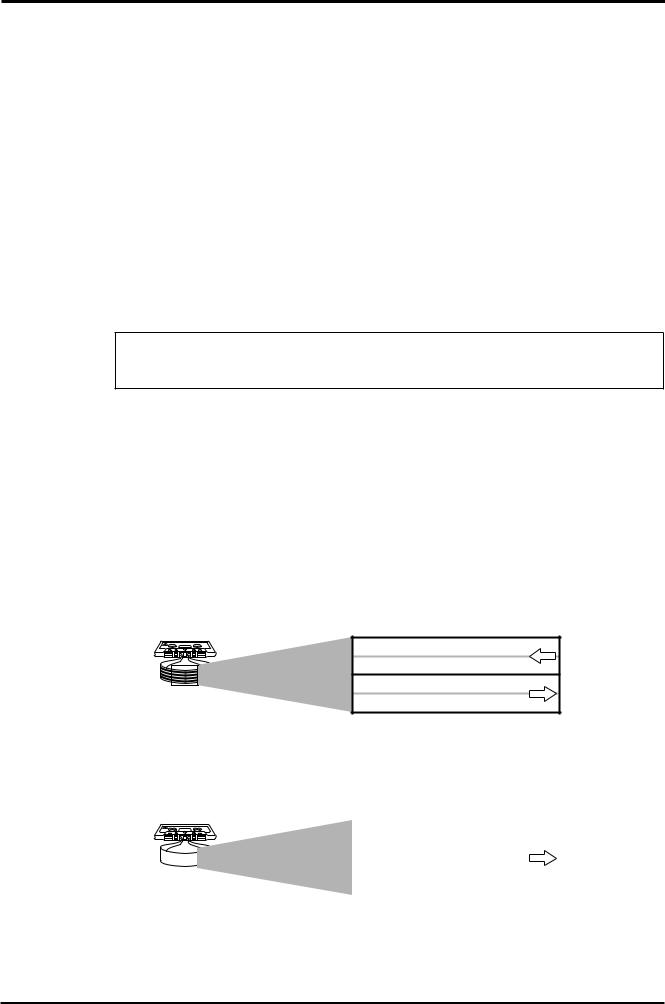
4
Buying Cassette Tapes for the MT400
It is important that you buy the correct type of cassette tape for use with your MT400. You should buy high-quality Type II (High Bias, 70 s EQ) chrome cassettes of 90 minutes or less, such as TDK SA or MAXELL CDXL II.
At normal speed, a 60-minute cassette provides about 15 minutes of recording time. That is because the tape runs at twice the speed of a normal cassette recorder and you can use only one side of the tape.
The following table shows the available recording times with three standard tape sizes:
Cassette Tape |
MT400 Recording Time |
|
(with the standard speed) |
||
|
||
|
|
|
C90 |
Approx. 22.5 minutes |
|
|
|
|
C60 |
Approx. 15 minutes |
|
|
|
|
C46 |
Approx. 11.5 minutes |
|
|
|
Note: We recommend that you use a brand new cassette tape for important recording. If you record on a used tape repeatedly, the recorded sound may skip or sound quality may deteriorate.
MT400 Recording Format
A normal cassette recorder uses only two tracks (i.e., left and right stereo channels) for each side (A and B). The transport direction of the A side is opposite that of the B side. The MT400 uses only one side of the cassette, and records and plays up to four tracks simultaneously or one at a time. Therefore, tapes with all four tracks recorded on the MT400 cannot be played on normal cassette players. If you try to play back a tape recorded with normal cassette recorders on the MT400, you will hear Tracks 3 and 4 play backwards.
Normal cassette recorder tracks
Side B (left channel)
Side B (right channel)
Side A (right channel)
Side A (left channel)
transport direction
transport direction
MT400 tracks
|
|
|
|
|
|
|
Track 1 |
transport |
|
|
|
|
|||||
|
|
|
|
|
|
|
Track 2 |
|
|
|
|
|
|
|
|
||
|
|
|
|
|
|
|
Track 3 |
direction |
|
|
|
|
|
|
|
||
|
|
|
|
|
|
|
||
|
|
|
|
|
|
|
|
|
|
|
|
|
|
|
|
Track 4 |
|
|
|
|
|
|
|
|
|
|
The tape speed of normal cassette recorders is 4.8 cm/second. On the other hand, the MT400 uses 9.5 cm/second as its standard speed to achieve high-quality sound.


 —Owner’s Manual
—Owner’s Manual

5
About dbx Noise Reduction
The MT400 uses the dbx noise reduction system to reduce tape hiss and keep your recordings clean and crisp. For the best performance, it is recommended that you use the dbx noise reduction for all your recordings. You should always use the dbx noise reduction system to correctly play back tapes that were recorded with the dbx system on.
Glossary
This section describes basic terminology used in this manual.
■ Input channel
A path (channel) for audio signal between a mixer input jack and the bus (see below). Signal input at an input jack is adjusted for the volume level and tonal quality here before being sent to the bus.
■ Track
The MT400 can record four individual sound sources simultaneously on the four sections of a cassette tape. This does not mean that the tape is cut into four pieces. The tape forms four magnetic bands along the length of the tape. Each magnetic recording band is called a “track”. The MT400 can use up to four tracks (Tracks 1–4).
■ Bus
A path where multiple audio signals are mixed into one signal. The MT400 offers the following buses that can be used depending on the purpose.
Stereo L/R bus — This bus is used to create a stereo signal. Stereo bus signal is output from the STEREO OUT L/R jacks. You can record stereo L bus signal to both Track 1 and 3 of the recorder section, and stereo R bus signal to both Track 2 and 4. To monitor stereo bus signals, use the MONITOR OUT L/R jacks. You can also monitor them via headphones.
Cue bus — This bus is used to create a monaural signal for monitoring, which is output from the MONITOR OUT L/R jacks. You can also monitor the signal via headphones.
AUX 1 and 2 buses — These buses are used to send out signals to connected effects processors from the AUX SEND 1 and 2 jacks in monaural. You can monitor the signals via headphones.
■ Overdubbing
Overdubbing is a technique used to record new sounds to empty tracks while listening to the sounds already recorded on other tracks.
■ Ping-pong recording
Ping-pong recording is a technique used to free up tracks by mixing one or two existing tracks to an unused track.
■ Mixdown
Mixdown is a technique used to mix the sounds into a balanced stereo mix and record it to a stereo master recorder. It is also called “tracking down”.


 —Owner’s Manual
—Owner’s Manual
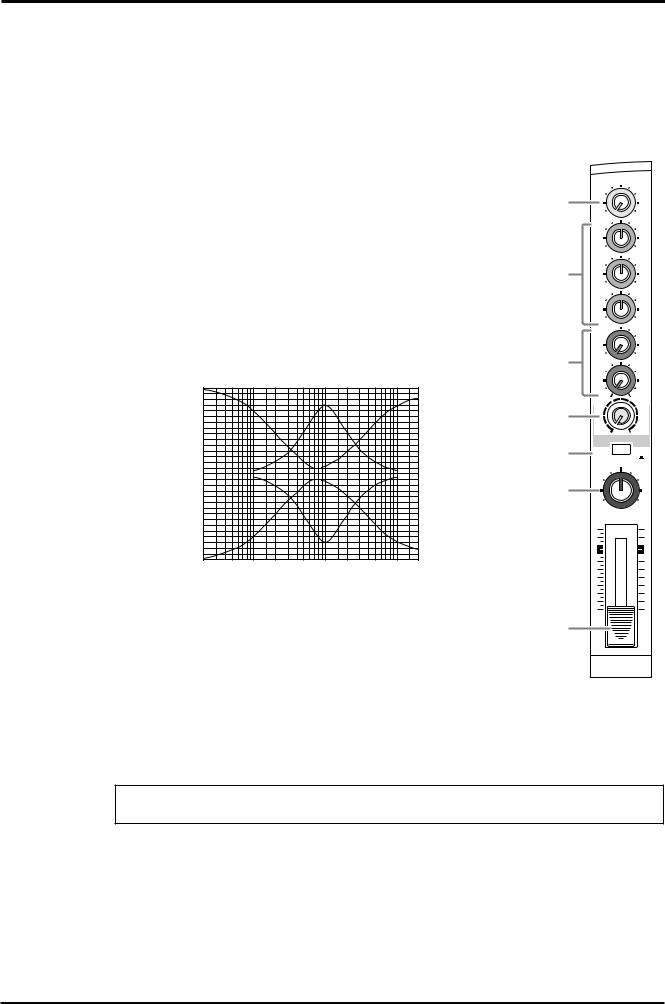
6
Touring the MT400
This section takes you on a tour of the MT400, identifying the various parts to familiarize you with your new recorder.
Input Channels
A GAIN control
This rotary control adjusts the sensitivity of the MIC/LINE INPUT jack d so that both microphone and line-level (such as a synthesizer) signals can be handled with ease.
B EQ control
These rotary controls are used to adjust a tonal quality of the high, middle, and low frequency bands independently. They boost (amplify) and cut (attenuate) the corresponding basic frequency in the range of ± 12 dB. A flat setting (i.e., no boost or cut) can be set quickly using the control’s center detentes.
|
15 |
|
|
|
|
|
|
|
|
|
|
10 |
|
|
|
|
|
|
|
|
|
(dB) |
5 |
|
|
|
|
|
|
|
|
|
Response |
0 |
|
|
|
|
|
|
|
|
|
|
|
|
|
|
|
|
|
|
|
|
|
–5 |
|
|
|
|
|
|
|
|
|
|
–10 |
|
|
|
|
|
|
|
|
|
|
–1520 |
50 |
100 |
200 |
500 |
1k |
2k |
5k |
10k |
20k |
Frequency (Hz)
HIGH: Basic frequency 12 kHz (shelving type)
MID: Basic frequency 1 kHz (peaking type)
LOW: Basic frequency 80 Hz (shelving type)
1
2
3
4
5
6
7
1
GAIN
LINE
 MIC
MIC
HIGH
–12
 +12
+12
MID
–12
 +12
+12
LOW
–12
 +12
+12
AUX  1
1 
0
 10
10
AUX 2
0 |
10 |
|
MIX |
CUE |
|
0 |
10 |
|
MIC/LINE |
TAPE |
|
to L |
MIC/ |
|
TAPE |
||
LINE |
 INPUT-FLIP
INPUT-FLIP
PAN
L
 R
R
10
9
8
7
6
5
4
3
2
1
0
C AUX controls
These rotary controls are used to send the input channel (1–4) signal to the AUX SEND 1 and 2 outputs. They are commonly used to adjust the level of signal sent to external effects processors.
Note: The AUX controls handle post-fader signals (signals that have passed through the faders 7). If the faders are lowered all the way, the AUX control settings will not be effective.
D CUE control
This control is used to adjust the level of Track (1–4) input signal and playback signal that will be sent to the cue bus. The CUE bus signals are output from the PHONES jack or the MONITOR OUT jack for monitoring.The CUE signal source depends on the [INPUT-FLIP] switch 5.


 —Owner’s Manual
—Owner’s Manual
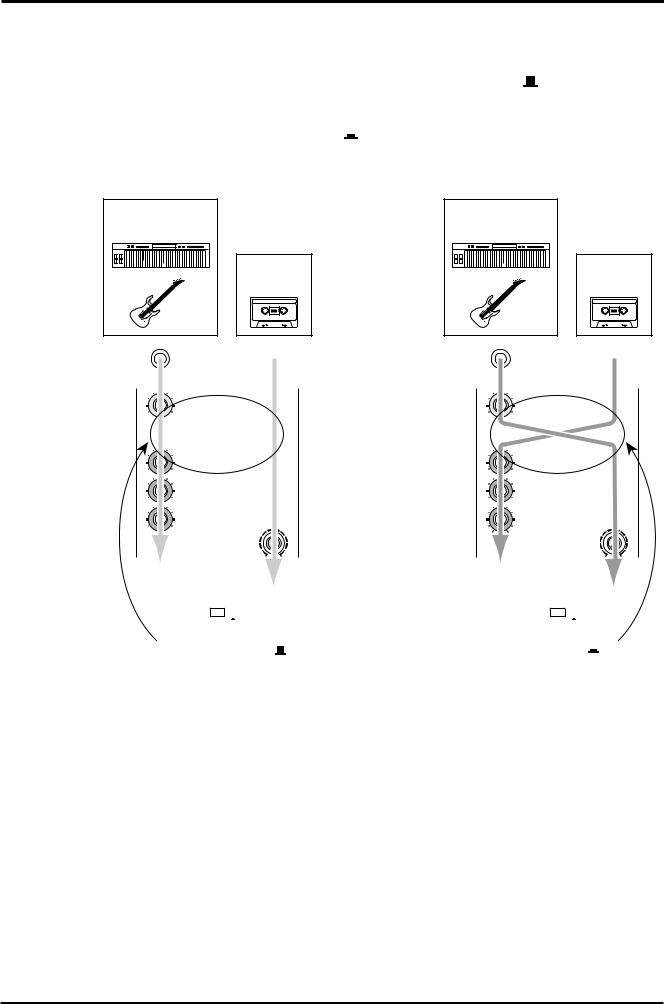
7
E INPUT-FLIP switch
This switch is used to select the destination of the signal input from the MIC/LINE INPUT jacks and the tape signal. With the switch in the MIC/LINE position (  ), the MIC/LINE input signal is fed to the ST bus via the input channel and the tape signal is fed to the CUE bus.
), the MIC/LINE input signal is fed to the ST bus via the input channel and the tape signal is fed to the CUE bus.
With the switch in the TAPE position (  ), the MIC/LINE input 1, 3 (2, 4) signal is fed to the ST L (ST R) bus and the tape signal is fed to the ST bus via the input channel.
), the MIC/LINE input 1, 3 (2, 4) signal is fed to the ST L (ST R) bus and the tape signal is fed to the ST bus via the input channel.
Musical instrument |
Musical instrument |
signal input from |
signal input from |
MIC/LINE INPUT jack |
MIC/LINE INPUT jack |
MT400 tape |
MT400 tape |
signal |
signal |
GAIN
LINE
 MIC
MIC
–12
 +12
+12
MID
–12
 +12
+12
LOW
– 
 +12
+12
MIX |
CUE |
0 |
10 |
To ST bus and tape
To CUE bus
MIC/
TAPE LINE
 INPUT-FLIP
INPUT-FLIP
GAIN
LINE
 MIC
MIC
HIGH
–12
 +12
+12
MID
–12
 +12
+12
LOW
– |
+12 |
MIX |
CUE |
|
|
|
10 |
To ST bus and tape
To ST bus
MIC/
TAPE LINE
 INPUT-FLIP
INPUT-FLIP
When INPUT-FLIP |
When INPUT-FLIP |
switch is MIC/LINE ( ) |
switch is TAPE ( ) |
F PAN control
This rotary control is used to adjust the stereo position (left or right) of input channel signal that will be sent to the Stereo bus. For recording via the Stereo bus (See page 22), turn this control all the way to the left to assign the signal to odd tracks (1, 3), and all the way to the right to assign the signal to even tracks (2, 4). For mixdown you can use it to pan the playback signal in the stereo mix.
GFader
For recording ([INPUT-FLIP] switch: MIC/LINE), use the fader to adjust the level of the input channel signal that is recorded to a track. For mixdown ([INPUT-FLIP] switch: TAPE), use it to adjust the playback level of each track. Unity gain is obtained when the fader is positioned about the 7–8 mark.
Unity gain: The condition where the output signal and input signal are at the same level, with signal-to-noise ratio and distortion set to optimum.


 —Owner’s Manual
—Owner’s Manual
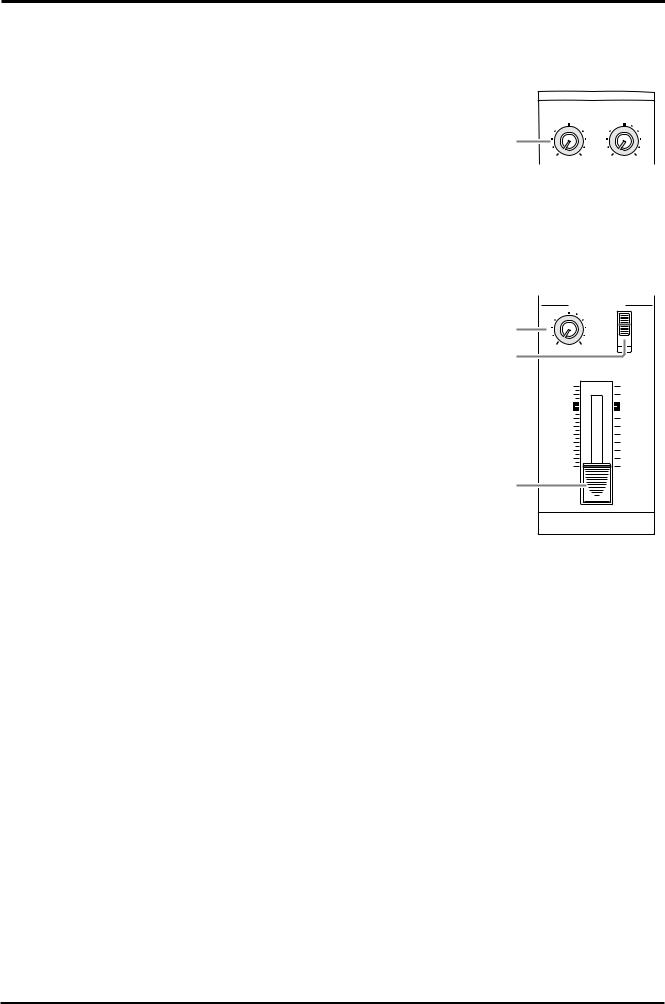
8
Stereo Inputs
H LEVEL controls
These rotary controls are used to adjust the level of the stereo input signals that are input at the STEREO INPUT jacks 5 and 6 or 7 and 8. These signals are usually sent to the Stereo bus for mixing with Input Channel 1–4 signals and tape signals.
Monitor/Master Section
I MONITOR LEVEL control
This rotary control adjusts the level of the monitor signal that is sent to the MONITOR OUT m and PHONES h jacks.
J Monitor select switch
This switch is used to select the signal source for the MONITOR OUT m and PHONES h.
STEREO ... This position selects the Stereo bus and allows you to monitor the STEREO OUT signal.
ST+CUE.... This position selects the Stereo bus and the CUE bus as the monitor source.
CUE ........... This position selects the CUE bus as the monitor source.
K STEREO fader
Use this fader to adjust the level of the stereo signal that is sent to the STEREO OUT jacks. Unity gain is obtained when the fader is positioned about the 7–8 mark.
Unity gain: See 7 Fader.
8
9 J
K
5L–6R 7L–8R
LEVEL
 LEVEL
LEVEL
0 |
10 |
0 |
10 |
MONITOR/PHONES
LEVEL
STEREO 
ST+CUE 
CUE 
MIN MAX
STEREO
10
9
8
7
6
5
4
3
2
1
0


 —Owner’s Manual
—Owner’s Manual
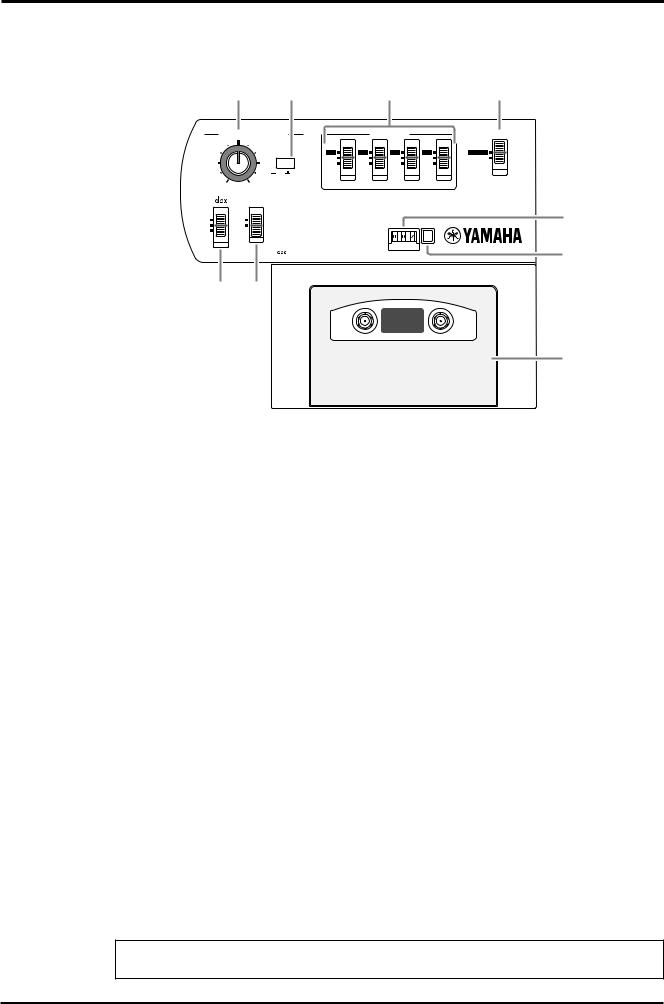
9
Recorder Section
|
L |
M |
|
N |
|
O |
|
TAPE SPEED CONTROL |
|
|
REC SELECT |
|
METER SELECT |
||
PITCH |
|
|
1 |
2 |
3 |
4 |
4TR |
|
|
|
|||||
|
|
|
OFF |
OFF |
OFF |
OFF |
STEREO |
|
|
|
L |
R |
L |
R |
|
|
+ |
4.8/ |
9.5 |
|
|
|
|
– |
|
|
|
|
|
|
|
|
ZERO STOP |
|
|
|
|
|
|
ON |
ON |
|
|
|
|
|
R |
OFF |
OFF |
|
|
|
|
|
|
SYNC |
|
|
|
|
|
|
|
|
|
|
NOISE REDUCTION SYSTEM |
|
|
|
S |
P Q
T
L PITCH control
This rotary control adjusts the tape speed in the range of ± 10%.
M Tape speed switch
This switch is used to select 4.8 cm/second or 9.5 cm/second for the tape speed. Set the switch to 9.5 ( ) for normal recording, and 4.8 (
) for normal recording, and 4.8 (  ) for playback of a tape recorded with a normal cassette tape recorder.
) for playback of a tape recorded with a normal cassette tape recorder.
N REC SELECT switches
These switches are used to select recording sources for tracks.
|
– |
|
...Input channel (1–4) signals are routed directly to the corresponding tracks for |
1 |
4 |
||
|
|
|
recording (direct recording). |
OFF............. |
|
The corresponding tracks are disabled for recording. |
|
L/R .............. |
|
The corresponding tracks are ready for recording and receive L channel (Tracks 1 |
|
|
|
|
and 3) or R channel (Tracks 2 and 4) signals. |
O METER SELECT switch
This switch selects the signal level to be displayed on the level meters a.
|
|
|
|
The level meters display the track input signal levels during recording and the |
|
4TR |
............ |
||
|
|
|
|
track output signal levels during playback. |
STEREO.... |
The level meters display the Stereo bus signal levels (signal output from the |
|||
|
|
|
|
STEREO OUT jacks). |
P dbx switch
Use this switch to turn on and off the dbx noise reduction system.
ON............... |
The dbx noise reduction system is turned on for all tracks. |
OFF............. |
The dbx noise reduction system is turned off for all tracks. |
SYNC ......... |
The dbx noise reduction system is turned off only for Track 4. |
Note: The SYNC setting is used for a special application in which Track 4 is used for synchronization. See page 41 for more information.


 —Owner’s Manual
—Owner’s Manual
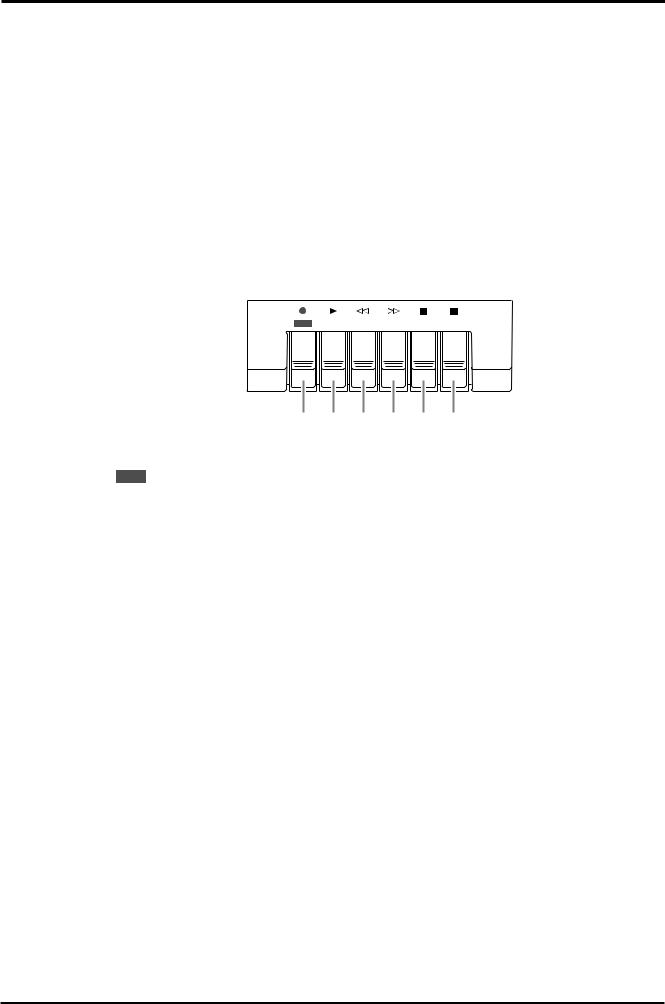
10
Q ZERO STOP switch
Use this switch to turn on and off the Zero Stop function. With this switch set to on (ON), the tape rewind automatically stops when the tape counter returns to just before “000”.
R Tape counter
This 3-digit tape counter indicates the tape position.
S Counter reset button
This button resets the tape counter value to “000”.
T Cassette compartment
Insert a cassette tape here.
Transport Section
REC |
PLAY |
REW |
FF |
STOP PAUSE |
U V W X Y Z
U REC button (●)
Pressing this button turns the PLAY button V on and starts recording on the currently available tracks. When you press this button during playback, recording starts from the point you press the button. This button is disabled if a tape is not set or write-protect tubs on the tape are broken.
V PLAY button (®)
Use this button to start playback of the tracks.
WREW button ( )
)
Use this button to rewind the tape.
XFF button ( )
)
Use this button to fast forward the tape.
YSTOP button (■)
Use this button to stop the tape transport.
ZPAUSE button ( )
)
Use this button to pause recording or playback. Pressing this button to stop recording or playback and pressing it again will resume recording or playback.


 —Owner’s Manual
—Owner’s Manual
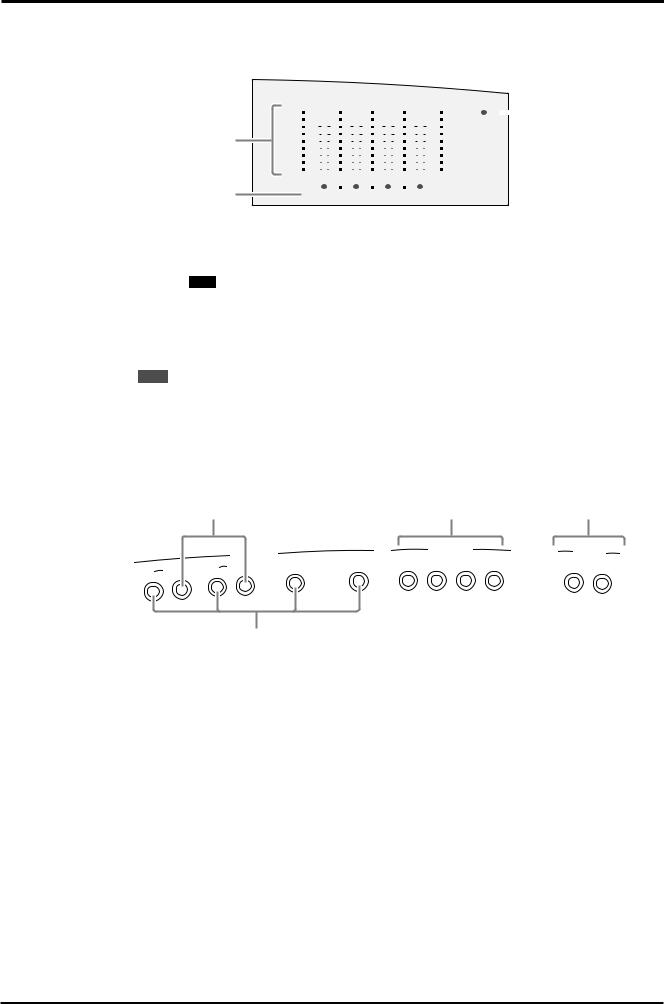
11
Meter Section
a
b
a Level meters
+6 |
|
|
|
|
|
|
|
|
|
|
|
|
|
|
|
|
|
|
|
+6 |
|
c |
|
|
|
|
|
|
|
|
|
|
|
|
|
|
|
|
|
|
|
|
|||||
|
|
|
|
|
|
|
|
|
|
|
|
|
|
|
|
|
|
|
POWER |
|
|
||
+3 |
|
|
|
|
|
|
|
|
|
|
|
|
|
|
|
|
|
+3 |
|||||
0 |
|
|
|
|
|
|
|
|
|
|
|
|
|
|
|
|
|
|
|
|
|
|
|
|
|
|
|
|
|
|
|
|
|
|
|
|
|
|
|
|
0 |
|
|
|
|||
|
|
|
|||||||||||||||||||||
–5 |
|
|
|
|
|
|
|
|
|
|
|
|
|
|
|
|
|
–5 |
|
|
|
||
|
|
|
|
|
|
|
|
|
|
|
|
|
|
||||||||||
|
|
|
|||||||||||||||||||||
–10 |
|
|
|
|
|
|
|
|
|
|
|
|
|
|
|
|
|
–10 |
|
|
|
||
|
|
|
|
|
|
|
|
|
|
|
|
|
|
||||||||||
|
|
|
|||||||||||||||||||||
|
|
|
|
|
|
|
|
|
|
|
|
|
|
|
|
|
|
|
|
|
|
|
|
REC |
|
|
|
|
|
||
|
1 |
|
2 |
|
3 |
|
4 |
|
L |
|
R |
|
|
|
|
These meters show the signal levels from –10 dB to +6 dB. When the METER SELECT switch
O is set to “ 4TR ”, they show the track signal levels during recording and playback. When the
METER SELECT switch is set to “STEREO”, they show the STEREO OUT signal levels.
b REC SELECT indicator
These indicators show which tracks are selected for recording. They flash when you select recording sources by the REC SELECT switches N, and light up continuously when you press the REC button to start recording.
c POWER indicator
This indicator lights up when you turn on the power to the unit.
Input/Output Section
|
|
e |
|
|
|
|
|
f |
|
|
|
|
|
T |
|
|
|
STEREO INPUT |
|
||
|
|
|
|
|
|
|
|
|
||
|
|
|
MIC/LINE INPU |
3 |
4 |
5L |
6R |
7L |
8R |
|
1 |
INSERT I/O |
2 |
INSERT I/O |
|||||||
|
|
|
|
|
|
|||||
|
|
|
|
|
|
|
||||
|
|
|
|
|
|
|
|
|||
|
|
|
|
|
|
|
|
|
||
g
AUX SEND
1 2
d
d MIC/LINE INPUTs 1–4
Use these 1/4" TRS phone jacks to connect microphones and electronic musical instruments such as a synthesizer to the MT400.
e INSERT I/O
Use these TRS phone jacks to output, then input channels 1 and 2 signals. Typically, signal processors, such as compressors, limiters, and noise gates are connected to these jacks. Signals output from the mixer section are processed on the effects processor and returned to the mixer via these jacks. (See page 28)
f STEREO INPUTs
Use these 1/4" phone jacks to connect line-level sound sources that have stereo outputs, such as a synthesizer and a CD player. They can also be used to return the processed stereo signals from external effects processors, such as a reverb unit. (See page 29)
g AUX SEND
Use these 1/4" phone jacks to output the channel signals adjusted by the AUX controls 3. You can use these as effect sends by connecting to the effects processors’ inputs. (See page 29)


 —Owner’s Manual
—Owner’s Manual
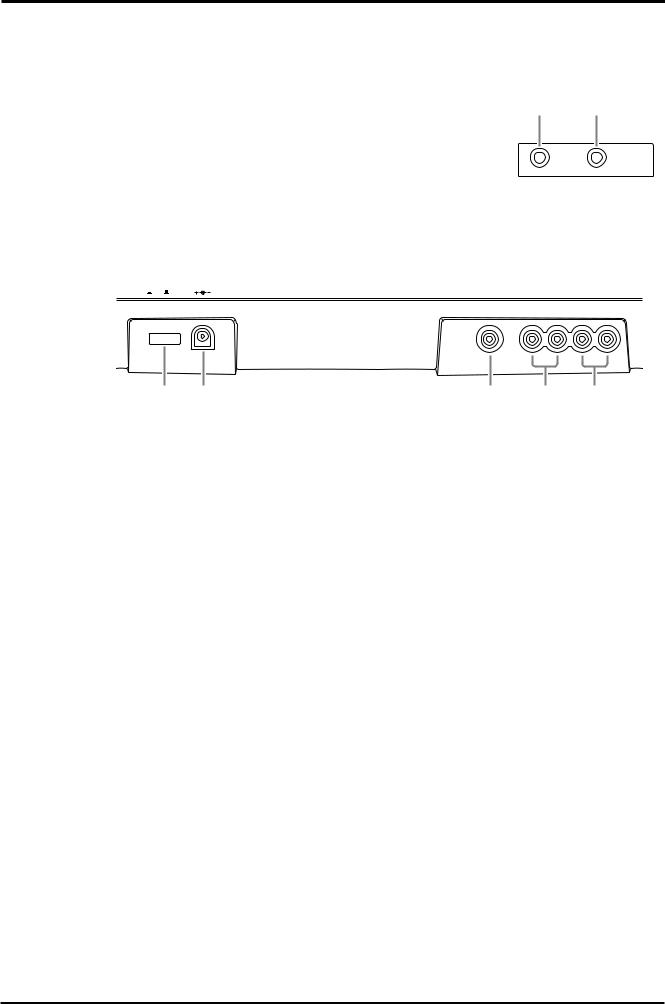
12
Front Panel
hPHONES
A pair of stereo headphones can be connected here for monitoring. The headphone signal is the same as the MONITOR OUT signal.
iPUNCH I/O
An optional footswitch, such as the Yamaha FC5, can be connected here for foot-controlled punch in/out.
h i
PHONES |
PUNCH I/O |
Rear Panel
POWER |
DC 12V |
SYNC OUT |
MONITOR OUT |
STEREO OUT |
||
ON/ |
OFF |
|
R |
L |
R |
L |
j k |
l m n |
j POWER ON/OFF switch
Use this switch to turn on and off the MT400.
k DC 12V
Connect the AC adapter here.
Use a 12 V AC adapter of at least 650 mA.
l SYNC OUT
Use this phono jack to individually output FSK and SMPTE synchronization signals recorded on the sync track (Track 4).
m MONITOR OUTs
Use these phono jacks to send the monitor signals. Connect your hi-fi system or powered speakers.
n STEREO OUTs
Use these phono jacks to output Stereo bus signal adjusted by the STEREO fader. Connect them to your master recorder’s stereo inputs for mixdown.


 —Owner’s Manual
—Owner’s Manual
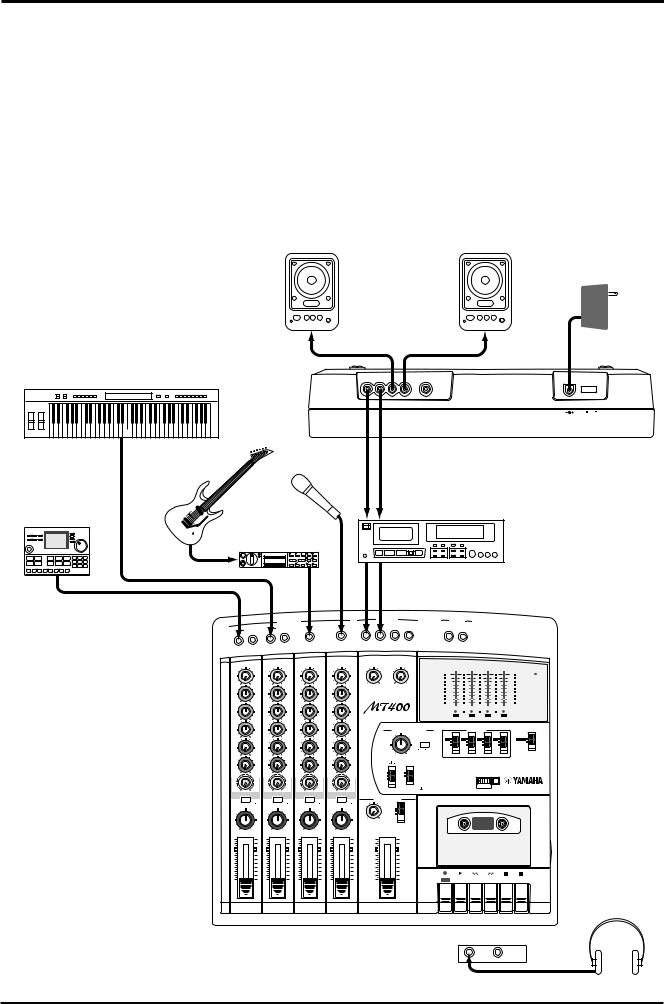
13
The First Session
This chapter explains how to record four tracks individually and mix your first MT400 session onto a master recorder.
Preparation
Quick-Start System
Powered speakers / |
AC adapter |
Hi-fi stereo system |
|
YAMAHA |
YAMAHA |
Keyboard
L |
R |
L |
R |
|
OFF |
ON/ |
STEREOOUT |
MONITOROUT |
SYNCOUT |
DC12V |
POWER |
||
Guitar  Microphone
Microphone
Master recorder
Rhythm machine
Guitar effects processor
YAMAHA
1
INSERT I/O
2
MIC/LINE INPUT INSERT I/O
|
|
|
STEREO INPUT |
|
|
3 |
4 |
5L |
6R |
7L |
8R |
AUX SEND
1 2
|
1 |
|
2 |
|
3 |
|
4 |
|
5L–6R |
7L–8R |
|
|
|
|
|
|
GAIN |
|
GAIN |
|
GAIN |
|
GAIN |
|
LEVEL |
LEVEL |
|
|
|
|
|
|
|
|
|
|
|
|
|
|
|
|
|
|
|
+6 |
|
|
|
+6 |
|
|
|
|
|
|
|
|
|
|
|
|
|
|
|
|
POWER |
LINE |
MIC |
LINE |
MIC |
LINE |
MIC |
LINE |
MIC |
0 |
10 |
0 |
10 |
+3 |
|
|
|
+3 |
|
|
|
|
|
||||||||||||
HIGH |
|
HIGH |
|
HIGH |
|
HIGH |
|
|
|
|
|
0 |
|
|
|
0 |
|
|
|
|
|
|
|
|
|
|
|
|
–5 |
|
|
|
–5 |
–12 |
+12 |
–12 |
+12 |
–12 |
+12 |
–12 |
+12 |
|
|
|
|
–10 |
|
|
|
–10 |
MID |
|
MID |
|
MID |
|
MID |
|
|
|
|
|
|
|
|
|
|
|
|
|
|
|
|
|
|
|
MULTITRACK CASSETTE RECORDER |
REC |
2 |
3 |
|
4 |
||
|
|
|
|
|
|
|
|
|
|
|
|
1 |
|
|||
–12 |
+12 |
–12 |
+12 |
–12 |
+12 |
–12 |
+12 |
|
|
|
|
L |
R |
|
|
|
LOW |
|
LOW |
|
LOW |
|
LOW |
|
|
|
|
|
|
|
|
|
|
|
|
|
|
|
|
|
|
|
|
TAPE SPEED CONTROL |
|
REC SELECT |
|
METER SELECT |
||
–12 |
+12 |
–12 |
+12 |
–12 |
+12 |
–12 |
+12 |
|
|
PITCH |
|
1 |
2 |
3 |
4 |
4TR |
AUX |
|
AUX |
|
AUX |
|
AUX |
|
|
|
|
|
|||||
1 |
|
1 |
|
1 |
|
1 |
|
|
|
|
|
OFF |
OFF |
OFF |
OFF |
STEREO |
|
|
|
|
|
|
|
|
|
|
|
|
L |
R |
L |
R |
|
|
|
|
|
|
|
|
|
|
|
|
4.8/ |
9.5 |
|
|
|
|
0 |
10 |
0 |
10 |
0 |
10 |
0 |
10 |
|
|
– |
+ |
|
|
|
|
|
AUX |
|
AUX |
|
AUX |
|
AUX |
|
|
|
|
|
|
|
|
|
|
2 |
|
2 |
|
2 |
|
2 |
|
|
|
|
|
|
|
|
|
|
ZERO STOP
0 |
10 |
0 |
10 |
0 |
10 |
0 |
10 |
ON |
ON |
MIX |
CUE |
MIX |
CUE |
MIX |
CUE |
MIX |
CUE |
OFF |
OFF |
|
|
|
|
|
|
|
|
SYNC |
|
0 |
10 |
0 |
10 |
0 |
10 |
0 |
10 |
|
|
MIC/LINE |
TAPE |
MIC/LINE |
TAPE |
MIC/LINE |
TAPE |
MIC/LINE |
TAPE |
|
|
to L |
|
to R |
|
to L |
|
to R |
|
|
|
TAPE |
MIC/ |
TAPE |
MIC/ |
TAPE |
MIC/ |
TAPE |
MIC/ |
|
MONITOR/PHONES |
LINE |
LINE |
LINE |
LINE |
LEVEL |
|
||||
INPUT-FLIP |
INPUT-FLIP |
INPUT-FLIP |
INPUT-FLIP |
|
|||||
|
|
|
|
|
|
|
|
|
STEREO |
PAN |
|
PAN |
|
PAN |
|
PAN |
|
|
ST+CUE |
|
|
|
|
|
CUE |
||||
|
|
|
|
|
|
|
|
MIN |
MAX |
L |
R |
L |
R |
L |
R |
L |
R |
|
STEREO |
|
|
|
|
|
|
|
|
|
|
10 |
|
10 |
|
10 |
|
10 |
|
|
10 |
9 |
|
9 |
|
9 |
|
9 |
|
|
9 |
8 |
|
8 |
|
8 |
|
8 |
|
|
8 |
7 |
|
7 |
|
7 |
|
7 |
|
|
7 |
6 |
|
6 |
|
6 |
|
6 |
|
|
6 |
5 |
|
5 |
|
5 |
|
5 |
|
|
5 |
4 |
|
4 |
|
4 |
|
4 |
|
|
4 |
3 |
|
3 |
|
3 |
|
3 |
|
|
3 |
2 |
|
2 |
|
2 |
|
2 |
|
|
2 |
1 |
|
1 |
|
1 |
|
1 |
|
|
1 |
0 |
|
0 |
|
0 |
|
0 |
|
|
0 |
 NOISE REDUCTION SYSTEM
NOISE REDUCTION SYSTEM
REC |
PLAY |
REW |
FF |
STOP PAUSE |
Headphones
PHONES |
PUNCH I/O |


 —Owner’s Manual
—Owner’s Manual
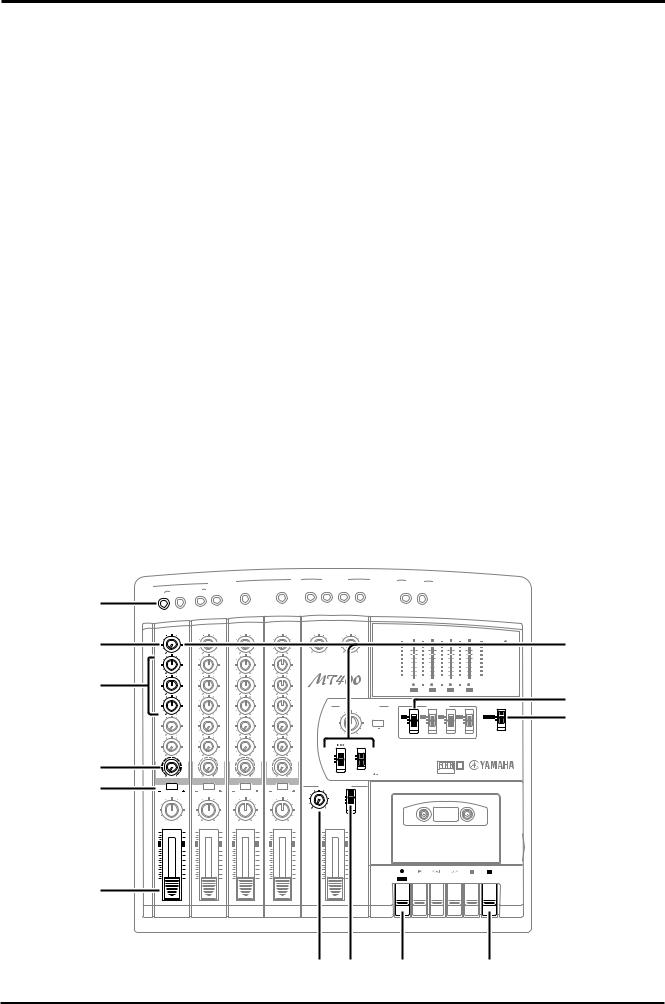
14
Turning On the MT400
1.Make sure that the plug of the supplied AC adapter is securely connected to the DC12V jack on the rear of the MT400.
2.Plug the other end of the AC adapter into a suitable AC outlet.
3.Press the POWER switch on the rear panel of the MT400. The POWER indicator in the meter section lights up.
Loading a Cassette Tape
Before loading a cassette tape, make sure the tape is not slack inside the cassette. Also, make sure the write-
protect tabs are not broken. If they are broken, you cannot record on the tape.
1.Open the cassette compartment cover.
2.Load the cassette into the compartment with the A side facing up.
3.Close the cassette compartment cover.
If it is a new tape, fast forward and rewind it once to prevent binding, which may occur due to the tape being tightly wound during manufacturing.
4. Press the [PLAY] button to start playback, and stop after about 20 seconds.
It is best not to use the first and last 20 seconds of a tape, as the splice between the leader and tape can cause distortion.
Recording the First Track
The MT400 allows signals input at MIC/LINE INPUT 1–4 to be directly recorded on Tracks 1–4 respectively (this is called “direct recording”). Connecting a sound source to MIC/LINE INPUT 1 will automatically select Track 1 for recording, and connecting another sound source to MIC/LINE INPUT 3 will automatically select Track 3 for recording. This is convenient for recording one sound source at a time.
This section explains how to record the first sound source in Track 1.
Preparation Before Recording
1
7
C
A 2
8
|
|
|
|
MIC/LINE INPUT |
|
4 |
|
STEREO INPUT |
|
AUX SEND |
||
|
|
|
|
3 |
5L |
6R |
7L |
8R |
1 |
2 |
||
1 |
INSERT |
I/O |
2 |
INSERT I/O |
||||||||
|
|
|
|
|
|
|
|
|
|
|
||
|
1 |
|
2 |
|
3 |
|
4 |
5L–6R |
|
7L–8R |
|
|
|
|
|
|
GAIN |
|
GAIN |
|
GAIN |
|
GAIN |
|
LEVEL |
|
LEVEL |
|
|
|
|
|
|
|
|
|
|
|
|
|
|
|
|
|
|
+6 |
|
|
|
+6 |
|
|
|
|
|
|
|
|
|
|
|
|
|
|
|
|
POWER |
LINE |
MIC |
LINE |
MIC |
LINE |
MIC |
LINE |
MIC |
0 |
10 |
0 |
10 |
+3 |
|
|
|
+3 |
|
|
|
|
|
||||||||||||
HIGH |
|
HIGH |
|
HIGH |
|
HIGH |
|
|
|
|
|
0 |
|
|
|
0 |
|
|
|
|
|
|
|
|
|
|
|
|
–5 |
|
|
|
–5 |
–12 |
+12 |
–12 |
+12 |
–12 |
+12 |
–12 |
+12 |
|
|
|
|
–10 |
|
|
|
–10 |
MID |
|
MID |
|
MID |
|
MID |
|
|
|
|
|
|
|
|
|
|
|
|
|
|
|
|
|
|
MULTITRACK CASSETTE RECORDER |
REC |
|
|
|
|
|||
|
|
|
|
|
|
|
|
|
|
|
|
|
1 |
2 |
3 |
4 |
–12 |
+12 |
–12 |
+12 |
–12 |
+12 |
–12 |
+12 |
|
|
|
|
|
L |
R |
|
|
LOW |
|
LOW |
|
LOW |
|
LOW |
|
|
|
|
|
|
|
|
|
|
|
|
|
|
|
|
|
|
|
|
TAPE SPEED CONTROL |
|
|
REC SELECT |
|
METER SELECT |
|
–12 |
+12 |
–12 |
+12 |
–12 |
+12 |
–12 |
+12 |
|
PITCH |
|
1 |
2 |
3 |
4 |
4TR |
|
AUX |
|
AUX |
|
AUX |
|
AUX |
|
|
|
|
|
|||||
1 |
|
1 |
|
1 |
|
1 |
|
|
|
|
|
OFF |
OFF |
OFF |
OFF |
STEREO |
|
|
|
|
|
|
|
|
|
|
|
|
L |
R |
L |
R |
|
|
|
|
|
|
|
|
|
|
|
|
4.8/ |
9.5 |
|
|
|
|
0 |
10 |
0 |
10 |
0 |
10 |
0 |
10 |
|
|
– |
+ |
|
|
|
|
|
AUX |
|
AUX |
|
AUX |
|
AUX |
|
|
|
|
|
|
|
|
|
|
2 |
|
2 |
|
2 |
|
2 |
|
|
|
|
ZERO STOP |
|
|
|
|
|
|
|
|
|
|
|
|
|
|
|
|
|
|
|
|
|
|
0 |
10 |
0 |
10 |
0 |
10 |
0 |
10 |
|
ON |
|
ON |
|
|
|
|
|
MIX |
CUE |
MIX |
CUE |
MIX |
CUE |
MIX |
CUE |
|
OFF |
|
OFF |
|
|
|
|
|
|
|
|
|
|
|
|
|
SYNC |
|
|
|
|
|
|
|
|
0 |
10 |
0 |
10 |
0 |
10 |
0 |
10 |
|
|
|
|
NOISE REDUCTION SYSTEM |
|
|
|
|
|
|
|
|
|
|
|
|
|
||||||||
MIC/LINE |
TAPE |
MIC/LINE |
TAPE |
MIC/LINE |
TAPE |
MIC/LINE |
TAPE |
|
|
|
|
|
|
|
|
|
to L |
MIC/ |
to R |
MIC/ |
to L |
MIC/ |
to R |
MIC/ |
MONITOR/PHONES |
|
|
|
|
|
|||
TAPE |
TAPE |
TAPE |
TAPE |
|
|
|
|
|
||||||||
LINE |
LINE |
LINE |
LINE |
LEVEL |
|
|
|
|
|
|
|
|
||||
INPUT-FLIP |
INPUT-FLIP |
INPUT-FLIP |
INPUT-FLIP |
|
|
|
|
|
|
|
|
|||||
|
|
|
|
|
|
|
|
|
STEREO |
|
|
|
|
|
|
|
PAN |
|
PAN |
|
PAN |
|
PAN |
|
|
ST+CUE |
|
|
|
|
|
|
|
|
|
|
|
|
|
CUE |
|
|
|
|
|
|
||||
|
|
|
|
|
|
|
|
MIN |
MAX |
|
|
|
|
|
|
|
L |
R |
L |
R |
L |
R |
L |
R |
STEREO |
|
|
|
|
|
|
||
|
|
|
|
|
|
|
|
|
|
|
|
|
|
|||
10 |
|
10 |
|
10 |
|
10 |
|
10 |
|
|
|
|
|
|
|
|
9 |
|
9 |
|
9 |
|
9 |
|
9 |
|
|
|
|
|
|
|
|
8 |
|
8 |
|
8 |
|
8 |
|
8 |
|
|
|
|
|
|
|
|
7 |
|
7 |
|
7 |
|
7 |
|
7 |
|
|
|
|
|
|
|
|
6 |
|
6 |
|
6 |
|
6 |
|
6 |
|
|
|
|
|
|
|
|
5 |
|
5 |
|
5 |
|
5 |
|
5 |
|
|
|
|
|
|
|
|
4 |
|
4 |
|
4 |
|
4 |
|
4 |
|
|
|
|
|
|
|
|
3 |
|
3 |
|
3 |
|
3 |
|
3 |
|
|
|
|
|
|
|
|
2 |
|
2 |
|
2 |
|
2 |
|
2 |
|
|
|
|
|
|
|
|
1 |
|
1 |
|
1 |
|
1 |
|
1 |
|
|
|
|
|
|
|
|
0 |
|
0 |
|
0 |
|
0 |
|
0 |
|
|
|
REC |
PLAY |
REW |
FF |
STOP PAUSE |
9
3
4
B 0 6 |
5 |


 —Owner’s Manual
—Owner’s Manual
